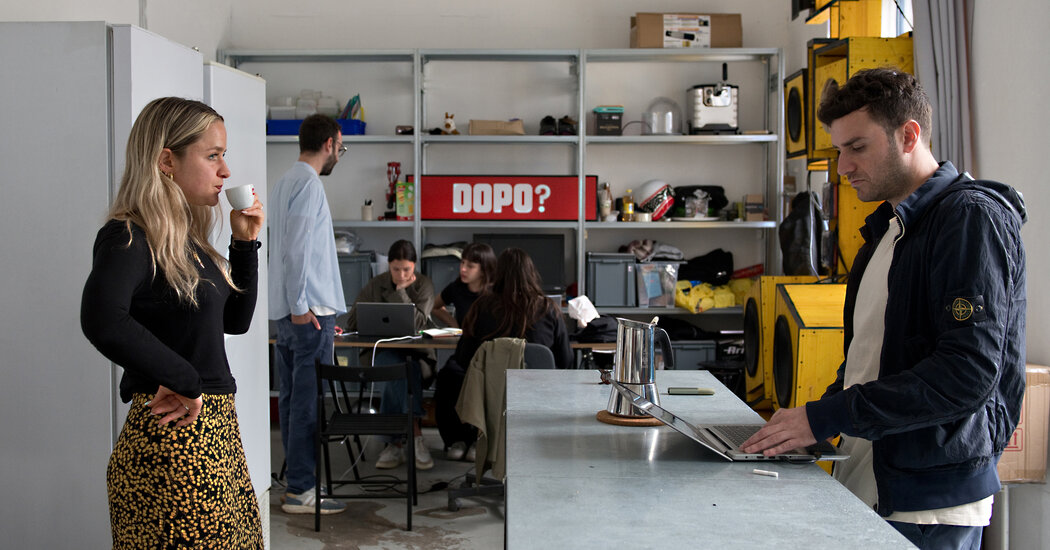This article is part of our Design special report previewing Milan Design Week.
In this city of 1.35 million, a particular ritual happens in the weeks leading up to the Salone del Mobile. Ads start popping up on Facebook and Instagram offering private rooms and entire apartments for a few hundred euros a night. Then, just before the doors open at the Fiera Milano — the exhibition center on the outskirts of Milan — residents pack up and move out of their homes, making way for the more than 300,000 fairgoers who descend on the city each April.
“We were fascinated by this phenomenon of people leaving their home just for the week of Salone,” said Salvatore Peluso, 34, one of the founders of Dopo, a creative space and cultural center in Milan’s southeast Corvetto neighborhood. During Milan Design Week, Dopo is presenting “Runaways,” an exhibition exploring the complicated topic of housing in Milan through a home envisioned by young designers that will also function as a real temporary residence for the duration of the week. This migration is not unique to Milan, or even its design week. Yet the April design festival dwarfs other happenings largely because most of its exhibitions are open to the public. (The four annual Milan fashion weeks, by contrast, are predominantly reserved for industry insiders.)
Similar trends can be observed in cities around the world during large-scale sporting events and concerts. But a sports car race or music festival does not provide a stage from which participants can critique the system. For Mr. Peluso, it was important to use the design week as a tool to discuss these issues, he said.
Dopo, which takes its name from “dopolavoro,” after-work social clubs organized by companies or unions, is in a former warehouse at the end of a dead-end street in an industrial neighborhood largely populated by building material depots and nightclubs. It was founded in 2022 by a collective of young creative workers and academics. In addition to Mr. Peluso, they are Bianca Felicori, a journalist and researcher; Carlotta Franco, Grazia Mappa and Gabriele Leo, all architects; and three members of the design studio Parasite 2.0 (Luca Marullo, Eugenio Cosentino and Stefano Colombo). During the year, the headquarters operates as a shared studio space that often opens its doors to exhibitions and parties.
The curators said they saw this “design week migration” as a microcosm of the larger problems surrounding housing precarity in Milan. According to Abitare, a real estate company, the short-term rental price of a furnished two-bedroom apartment jumps 245 percent during Design Week. In the Brera neighborhood, where many of the high-end design showrooms are based, an apartment costs an average of 7,000 euros (about $7,500) for the week.
Profit-making opportunities have led to an explosion of homes that have been converted into short-term rental units, exacerbating the already squeezed housing stock. The monthly average rent for a two-bedroom in Milan is €1,850 — 10 percent higher than in 2022.
The proliferation of short-term rentals can partly be attributed to a shortage of hotels. According to Milan’s tourism board, almost 11 million people visited in 2023, yet the city counted merely 448 hotels. Compare that with Madrid, which has a similar numbers of visitors and more than 800 hotels to accommodate them.
All of these factors converge to create a system where students, other young designers and enthusiasts are priced out of visiting Milan Design Week, which for decades has been an important place to discover new work and network within the industry. At the same time, those who live here feel the effects year-round as they compete for apartments in desirable neighborhoods that now host increasing numbers of short-term visitors.
Indeed, the skyrocketing cost of rent set off protests last year, with students across Italy setting up tents outside campus buildings to highlight the untenable cost of living — a movement the Dopo collective said factored into its decision to focus on housing at Milan Design Week this year.
The main exhibition consists of shelters designed by different groups from across Europe, said Ms. Franco, 33. One bedroom is the creation of Abadir Academy, a design school in Sicily, with Ortigia Sound, an electronic music festival. In March, the seamstress Greta Naselli organized a workshop for the academy’s students, who scoured local bazaars for fabric scraps that they then sewed into tents inspired by the vibrant awnings shading southern Italian markets. The shelter will be repurposed as a sunshade during Ortigia Sound’s event in Syracuse, Sicily, in August.
A second bedroom was built by the Milanese architectural collective Zattere using discarded materials found on the Dopo premises to create a temporary sleeping space.
For the third bedroom, Cecilia Casabona, a curator from Rotterdam, invited young Dutch designers — who are experiencing a housing crisis of their own — to supply makeshift furnishings. “The Dutch Embassy of Living,” as this project is called, includes a carpet and fireplace by Jonas Hejduk; colorful, abstract lighting by Diego Faivre and Hugo Béhérégaray; seating by Teun Zwets; and two portable beds by Flora Lechner. The beds are based on Ms. Lechner’s Odd Size Baggage, furniture that folds down to fit into an airplane’s overhead compartment.
“As a student, housing is always an issue,” Ms. Lechner said. A 2020 graduate of the Design Academy Eindhoven, in the Netherlands, she recalled some of her classmates living in campsites for the first months of school. Without support, the cost of exhibiting at Milan Design Week while studying can be prohibitive. “Some people just send their work but don’t come themselves,” she said.
Instead of conventional product presentations, several up-and-coming design firms are offering multidisciplinary experiences at Dopo. The Berlin-based Bottone engineered a sound performance for the living room. Zerogloss, from Vicenza, Italy, is running workshops in the kitchen based on cooking and sharing meals. And the 12-meter (39-foot) dining room table created by Felix Pöttinger of Munich in collaboration with the carpentry and design studio Eham, in Hausham, is the site of dinner parties and round-table discussions based on the theme of conviviality.
For the evenings, sleepover guests have organized additional public events, including a meditation session, an ambient music concert and a tea ceremony, in exchange for accommodation. “We want an environment that is super relaxing,” Mr. Peluso said.
Dopo’s curators didn’t have to look far for creative inspiration. Ms. Felicori, 29, pointed to radical Italian collectives of the 1960s that used temporary installations to explore novel modes of living, like Archigram’s 1971 “Instant City,” an inflatable utopian experiment in communal housing that lasted for three days on the island of Ibiza. “It’s a performance of a domestic space,” she said. “In a world that is going faster and faster, we are proposing something slow.”
A few other Design Week projects explore alternative ideas of shelter. In the Tortona district, the cultural center Base is holding a multipronged exhibition titled “The Convivial Laboratory — Camp.” On the building’s roof, Parasite 2.0 has built a temporary campsite that will host Base’s designers-in-residence as well as students and other cultural organizers.
And IED, the European design institute, has invited students to stay free of charge for two nights at a makeshift campsite on a sports field in the Navigli district, partnering with Ikea and the outdoor company Ferrino to furnish the tents. Riccardo Balbo, the school’s academic director, said he saw it as an educational opportunity.
“As a school, our mission should be fostering curiosity, which means facilitating a younger generation to see new things,” Mr. Balbo said. “If we put this into the context of the Salone, gentrification in the city, increasing rents and the rising cost of life, then we should simply try to facilitate students to come and see.”
Integrating young people in Milan Design Week is also a goal of the governing body of the Salone del Mobile, led by Maria Porro, the director of marketing and communications at the furniture company Porro.
The Salone del Mobile has recently partnered with the Milan Polytechnic University to study the fair’s economic and social impact on the region. Among the areas of research are the effects on temporary accommodation and permanent housing in the city.
Though the results of the study won’t be released until later this year, the fair has lowered its admission fee to €20 from €55 for students “because we know that students are the future,” Ms. Porro said.
By lowering the barrier of inclusion for students and young people to participate in Milan Design Week, and sparking a conversation about the factors that inhibit them, the curators of “Runaways” see it as an opportunity to reconnect to the more communal — rather than corporate — aspects of design.
“It’s about exhibiting an environment that is totally collective,” Ms. Franco said. “Which is something we really need to rebuild in design.”

